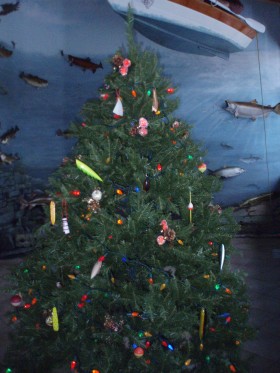 The holiday tree near the fish exhibit in the entry level of Crossroads at Big Creek celebrates the Great Lakes. Friends of Crossroads decorated it with all things lake —little lighthouses, toy boats, lures, and bobbers. But no stars! Which seems odd. Stars seem ubiquitous this time of year. From the five- pointed star high above shipyards to six-pointed Stars of David and 26 -pointed (I lost count–had to look it up) Moravian Star, stars are important symbols of the season. Or what we call stars.
The holiday tree near the fish exhibit in the entry level of Crossroads at Big Creek celebrates the Great Lakes. Friends of Crossroads decorated it with all things lake —little lighthouses, toy boats, lures, and bobbers. But no stars! Which seems odd. Stars seem ubiquitous this time of year. From the five- pointed star high above shipyards to six-pointed Stars of David and 26 -pointed (I lost count–had to look it up) Moravian Star, stars are important symbols of the season. Or what we call stars.
Real stars do not have points. They are shaped more like a popcorn ball than the shape we call “star.” And that isn’t even a good analogy, because popcorn balls are solid and stars are gas–mostly hydrogen and helium.
The good folks at NASA (the National Aeronautics and Space Administration) put out wonderful educational materials. To explain interior of the Sun, they suggest imagining “a thick-bottomed pot sitting on a stove…the pot is filled with boiling water and some strands of spaghetti.
“You can think of the Sun’s dense CORE as the burner of the stove, generating energy. The core blends into the RADIATIVE ZONE. Like the thick bottom of the pot, the material is still very dense but the heat still transfers through the pot.”
“The CONVECTIVE ZONE is like water boiling in the pot. Deep in the convective zone is where the magnetic field lines are generated and then get twisted up (like the strands of spaghetti in the boiling pot of water.) And imagine that a strand of the boiling spaghetti looping up the the surface of the water. Sometimes the Sun’s magnetic field pop throught the Sun’s surface, called the PHOTOSPHERE. ,
Light energy takes hundreds of thousands of years to travel from the core of the Sun to its surface, but according to NASA, “Once out of the Sun, it zips across the 93 million miles to the Earth in about 8 minutes.”
Some of that light will hit the roof of our new Maintenance Building where, for the past several week, students from the NWTC Solar Technology Program in collaboration with Lake Michigan Wind and Sun,Ltd. have been installing Crossroads’ third solar array. We anticipate these solar panels will generate more electricity than we will need without using fossil fuel or polluting air in any way.
We perceive our own star as spherical, so why do we imagine points on other stars? Well, stars give off light. It may take a few years or hundreds or even thousands of years for the light to reach to us, but just before the rays of light reaches our eyes, it has to pass through several layers of air.
When the light passes through the layers of atmosphere, the air acts like a lens and bends the light ever so slightly in some random direction. The next layer also bends the light in a different direction. The more layers of air, the more turbulent the layers, the more times the light ray is bent. When light reaches our eyes, it seems to jiggle slightly….to twinkle, and we perceive the star as have points.
If you would like to enjoy the twinkling stars in the December sky, the members of the Door Peninsula Astronomical Society are eager to help you. They are offering a free introduction to the night sky to teach the basics, such as locating constellations and reading a sky map. The classes will be offered Saturday December 8 and Wednesday, December 12 at 7:00 and will meet at the Astronomy Campus. A planetarium presentation will be offered if the skies are cloudy.


